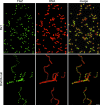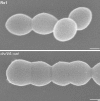Streptococcus pneumoniae DivIVA: localization and interactions in a MinCD-free context
- PMID: 17098892
- PMCID: PMC1797354
- DOI: 10.1128/JB.01168-06
Streptococcus pneumoniae DivIVA: localization and interactions in a MinCD-free context
Abstract
To clarify the function of DivIVA in Streptococcus pneumoniae, we localized this protein in exponentially growing cells by both immunofluorescence microscopy and immunoelectron microscopy and found that S. pneumoniae DivIVA (DivIVA(SPN)) had a unique localization profile: it was present simultaneously both as a ring at the division septum and as dots at the cell poles. Double-immunofluorescence analysis suggested that DivIVA is recruited to the septum at a later stage than FtsZ and is retained at the poles after cell separation. All the other cell division proteins that we tested were localized in the divIVA null mutant, although the percentage of cells having constricted Z rings was significantly reduced. In agreement with its localization profile and consistent with its coiled-coil nature, DivIVA interacted with itself and with a number of known or putative S. pneumoniae cell division proteins. Finally, a missense divIVA mutant, obtained by allelic replacement, allowed us to correlate, at the molecular level, the specific interactions and some of the facets of the divIVA mutant phenotype. Taken together, the results suggest that although the possibility of a direct role in chromosome segregation cannot be ruled out, DivIVA in S. pneumoniae seems to be primarily involved in the formation and maturation of the cell poles. The localization and the interaction properties of DivIVA(SPN) raise the intriguing possibility that a common, MinCD-independent function evolved differently in the various host backgrounds.
Figures







Similar articles
-
Making a point: the role of DivIVA in streptococcal polar anatomy.J Bacteriol. 2007 Feb;189(4):1185-8. doi: 10.1128/JB.01710-06. Epub 2006 Nov 17. J Bacteriol. 2007. PMID: 17114258 Free PMC article. No abstract available.
-
Identification of a polar targeting determinant for Bacillus subtilis DivIVA.Mol Microbiol. 2004 Dec;54(5):1237-49. doi: 10.1111/j.1365-2958.2004.04363.x. Mol Microbiol. 2004. PMID: 15554965
-
A novel component of the division-site selection system of Bacillus subtilis and a new mode of action for the division inhibitor MinCD.Mol Microbiol. 2008 Dec;70(6):1556-69. doi: 10.1111/j.1365-2958.2008.06501.x. Epub 2008 Oct 23. Mol Microbiol. 2008. PMID: 19019154
-
Recent advances on the development of bacterial poles.Trends Microbiol. 2004 Nov;12(11):518-25. doi: 10.1016/j.tim.2004.09.003. Trends Microbiol. 2004. PMID: 15488393 Review.
-
Diverse paths to midcell: assembly of the bacterial cell division machinery.Curr Biol. 2005 Jul 12;15(13):R514-26. doi: 10.1016/j.cub.2005.06.038. Curr Biol. 2005. PMID: 16005287 Review.
Cited by
-
Construction of improved tools for protein localization studies in Streptococcus pneumoniae.PLoS One. 2013;8(1):e55049. doi: 10.1371/journal.pone.0055049. Epub 2013 Jan 22. PLoS One. 2013. PMID: 23349996 Free PMC article.
-
EF1025, a Hypothetical Protein From Enterococcus faecalis, Interacts With DivIVA and Affects Cell Length and Cell Shape.Front Microbiol. 2020 Feb 12;11:83. doi: 10.3389/fmicb.2020.00083. eCollection 2020. Front Microbiol. 2020. PMID: 32117116 Free PMC article.
-
Movement dynamics of divisome proteins and PBP2x:FtsW in cells of Streptococcus pneumoniae.Proc Natl Acad Sci U S A. 2019 Feb 19;116(8):3211-3220. doi: 10.1073/pnas.1816018116. Epub 2019 Feb 4. Proc Natl Acad Sci U S A. 2019. PMID: 30718427 Free PMC article.
-
Characterisation of the MutS and MutL Proteins from the Pseudomonas avellanae Mismatch Repair (MMR) System.Open Microbiol J. 2012;6:45-52. doi: 10.2174/1874285801206010045. Epub 2012 May 25. Open Microbiol J. 2012. PMID: 22670163 Free PMC article.
-
Suppression and synthetic-lethal genetic relationships of ΔgpsB mutations indicate that GpsB mediates protein phosphorylation and penicillin-binding protein interactions in Streptococcus pneumoniae D39.Mol Microbiol. 2017 Mar;103(6):931-957. doi: 10.1111/mmi.13613. Epub 2017 Feb 7. Mol Microbiol. 2017. PMID: 28010038 Free PMC article.
References
-
- Ben-Yehuda, S., D. Z. Rudner, and R. Losick. 2003. RacA, a bacterial protein that anchors chromosomes to the cell poles. Science 299:532-536. - PubMed
-
- Buddelmeijer, N., and J. Beckwith. 2004. A complex of the Escherichia coli cell division proteins FtsL, FtsB and FtsQ forms independently of its localization to the septal region. Mol. Microbiol. 52:1315-1327. - PubMed
-
- Claverys, J. P., M. Prudhomme, I. Mortier-Barriere, and B. Martin. 2000. Adaptation to the environment: Streptococcus pneumoniae, a paradigm for recombination-mediated genetic plasticity? Mol. Microbiol. 35:251-259. - PubMed
-
- Cole, R. M., and J. J. Hahn. 1962. Cell wall replication in Streptococcus pyogenes. Science 135:722-724. - PubMed
Publication types
MeSH terms
Substances
LinkOut - more resources
Full Text Sources

